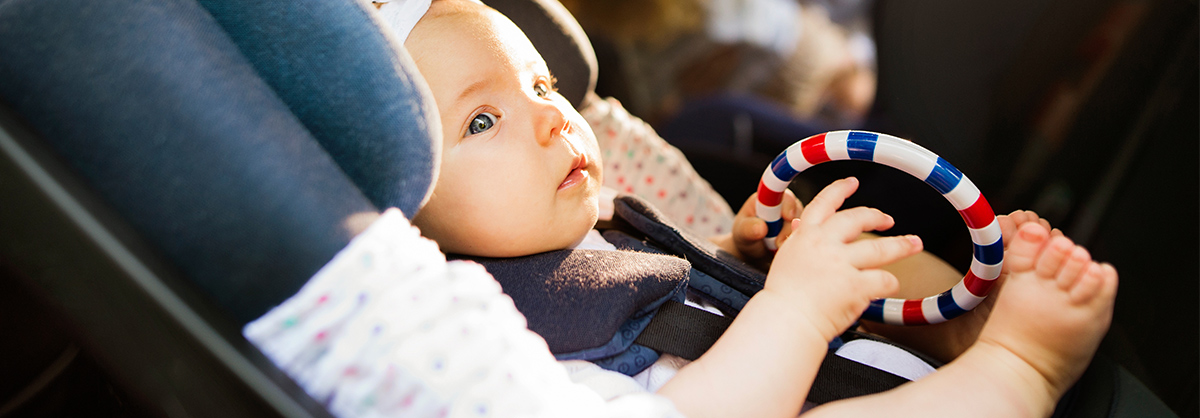
1Whether you’re taking your kids on a road trip to Grandma’s or just a quick trip to the grocery store, how can you be sure they’re safe?
It is estimated that over 1,600 children under 15 die in motor vehicle accidents each year in the United States, and the American Academy of Pediatrics (AAP) reports that traffic accidents are the leading cause of death for children age 4 and under.
While you may think that simply buckling up is the right move, the truth is that standard safety belts are designed for adult bodies, and both safety belts and airbags can cause severe injuries to children in the event of an accident.
The best way to keep kids safe in the car is by correctly installing and using age-appropriate child safety seats.
- Child safety seats reduce the risk of injury up to 82% compared with children wearing typical seat belts
- Child safety seats reduce the risk of death by 28% compared to seat belts
- Booster seats for kids ages 4 to 8 reduce the risk of non-fatal injury by 45% compared to seat belts
The effectiveness of child safety seats has led many states to enact laws requiring their use, and your child’s age, weight and height all play a role in which car seat you should purchase, and when your child is ready to safely use a regular seat belt.
Let’s take a look at child passenger safety laws in Missouri, along with recommendations from the AAP.
Missouri Car Seat Laws
Missouri Law reinforces the fact that standard safety belts are designed for adults and are not sufficient to protect children in case of a car crash.
How do you know which car seat to buy? Missouri has the following requirements based on the age and weight of your child:
- A rear-facing safety seat is required until age 1, or until the child weighs at least 20 pounds
- An appropriate child passenger restraint system is required for children under 4 years old or who weigh less than 40 pounds
- A booster seat is required for children ages 4 to 7 who weigh 40 pounds or more
- Children 8 and older may utilize an adult seatbelt if they weigh at least 80 pounds or stand at least 4’9” in height
All children under 16 must be properly secured, and the fine for violations is $50 plus court costs. The requirements do not apply to children who are being transported in a public school bus or by a public carrier for hire.
Remember that laws vary from state to state, so you’ll want to keep this in mind when driving across state lines with your child.
Car & Booster Seat Guidelines from the American Academy of Pediatrics
The American Academy of Pediatrics has published safety seat recommendations that actually go beyond what is required by law in many states, including Missouri. The AAP encourages parents to wait as long as possible before “graduating” their child to the next level of safety seat protection.
- Rear-facing safety seats should be used as long as possible. Ideally, you should continue to use a rear-facing seat until your child outgrows the maximum weight or height allowed by the manufacturer. Many convertible seats can be used rear-facing until the child is at least 2 years old and will accommodate children who weigh up to 35 to 40 pounds.
- Once your child outgrows a rear-facing seat, use a forward-facing seat until at least age 4, and continue to use it until the child outgrows the maximum height and weight limit allowed by the manufacturer.
- Once the forward-facing seat is outgrown, use a belt-positioning booster seat until the lap and shoulder safety belts fit properly — which is typically when the child reaches at least 4’9” in height, sometime between the ages of 8 and 12.
- All children under 13 must ride in the back seat.
When is your child ready for an adult seat belt? Use the following criteria to determine whether it fits correctly:
-
- The shoulder belt fits across the middle of the chest, not the neck
- The lap belt fits snugly across the upper thighs, not the belly
- Your child can sit comfortably against the seat back without slouching
- Your child’s knees comfortably bend over the edge of the seat, with feet flat on the floor
- Your child can stay in this position comfortably for the duration of the trip
By correctly installing the appropriate car seat for your child’s age and height, you can reduce his or her risk of severe injuries or death in case of a crash.
And if your child has been injured because of a car accident or a defective car seat, contact Eng & Woods today. Our attorneys will make sure your rights are protected and you get the compensation you deserve.
By
Eng & Woods
|
Published
September 28, 2018
|
Posted in
